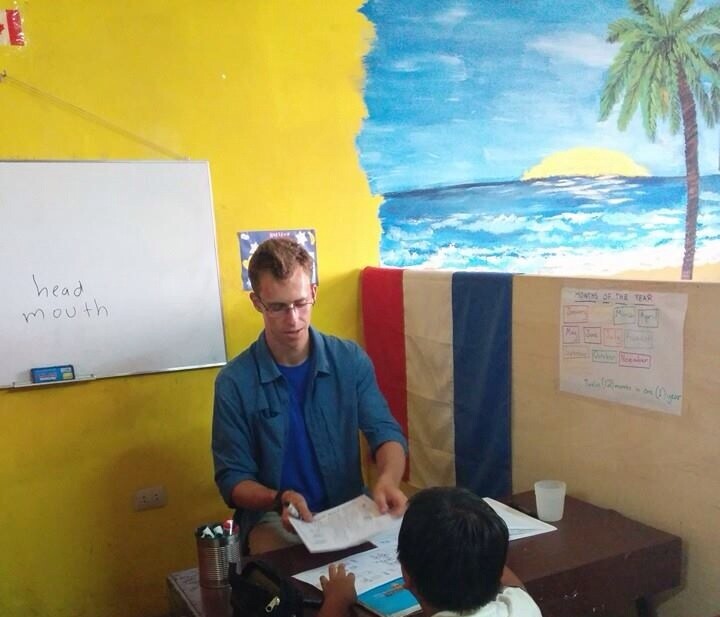
The following post is from Brady Gilliam, a 2014 Global Gap Year Fellow. UNC’s Global Gap Year Fellowship is housed in and staffed by the Campus Y. Find out more about the fellowship on our GGYF Facebook page!
Currently I’m in a city called Cajamarca, for their famous celebration of Carnaval (Latin American Mardi Gras.) Today has been really crazy – the people celebrate by parading through the streets singing and banging drums, waving flags, and throwing massive quantities of paint, water, and talcum powder at everyone around them. Anyways, I want to begin this blog with an apology – I realized today that February has passed and I completely forgot to write even one blog! I’m sorry!
To be honest, I have been completely, suddenly busy since I’ve arrived here at Horizon Schools Peru, and I haven’t even thought about the blogs I’ve committed to write. I don’t mean to say this as an excuse, but as an explanation – as it turns out, having a full-time teaching job is a TON of work. I have to say, I didn’t give my high school teachers nearly enough credit. Thinking back, I feel a little ashamed that I didn’t thank them every time I walked out of their classroom, because now I know how much time and work they probably put into every lesson. For those of you who have never been a teacher, take it from me that it’s lot of work. I’m currently teaching five one-hour English classes each day, to students of all different levels. However, as I’m sure you’ve guessed, my work day is not five hours long. It can take up to an hour to plan each lesson, including studying the curriculum I’ve put together (with the help of the massive amouts of ESL teaching resources and materials we have in our bookshelves) and the present class’s progress along it, the brainstorming and lesson-writing phase, and then printing out, making and gathering the necessary materials. I put a lot into each lesson, not only because I have to and expectations are high for the teachers here, but because I love it and I want my kids to receive a meaningful, engaging learning experience each time they come to our English school.
All of the volunteers (there are currently seven of us, soon to be nine) live together in our NGO’s two-story town-home style building. The front part of the building is taken up by classrooms, while the back parts are our living quarters, including bedrooms, a living room, a back patio/courtyard, and a kitchen. We rotate cooking nights, and I have to say people have been preparing some excellent meals, so the competition is pretty tough. We’re a pretty international group, with members primarily from the US but also from Denmark, the UK, and soon from Austria. Most of us speak Spanish with a fair degree of fluency, if not perfectly – since I’ve been here, my own Spanish skills have improved tenfold, and continue to get better every day. I’d definitely say I’m close to being fluent in the language, as I basically have to be to teach English grammar to people (especially kids) who don’t speak English conversationally. All the volunteers here get along really well as a group, and we’ve taken a few small trips together, one to a tiny, isolated mountain village called Quinden, and this trip to Cajamarca for Carnaval. Plus, we work together well – proof is in the community trash cleanup day we organized with our kids, which was a huge success!
As for the volunteers’ work day, we each teach five (sometimes more if we choose) classes per day. The groups we teach are small, usually no more than four students at a time, and the lessons we plan are personalized for each group. All of us have our own classroom that we can personalize however we want during our time at the school (grammar jingle posters, anyone?). We also have one certified TEFL (teaching English as a foreign language) teacher volunteering here – she also has a university degree in education – and she trains the other volunteers and helps them develop curriculum, as well as teaching her own five classes per day. The lessons here are completely free for students, and are known to be high-quality, so there is always a long line of people on our waiting list. Unfortunately, the number of spots available in the school grows and shrinks depending on the number of volunteers working.
The school is located in a very dangerous and low-income area of Trujillo called La Esperanza, where many children cannot afford a quality education and do not have access to good English teachers. For these kids, learning English can be a way to escape the generational cycle of poverty in which most of them are trapped – it can give them access to a great variety of opportunities which they would not otherwise be able to pursue, such as entry into a highly-ranked university, or a well-paying and stable job. As my relationship with my students grows, I’ve begun to feel a strong sense of responsibility for them and for their education, which is a very humbling thing. Nothing will make you take your job seriously like a high level of accountability and emotional investment. Still, all the work I’ve been putting in has been completely worth it – seeing my students progress throughout the first month I’ve been here has been more rewarding than I could have imagined. My best moment yet happened just a few days ago, when I told one class our time was up and they groaned audibly, as if learning how to do present simple tense conjugations was something they had been seriously enjoying! Not saying I’m a fantastic teacher, and I’m not always as exciting as I’m aiming to be, but when things like that happen it feels really good.
Anyways, let me apologize again for the tardiness of this post – I hope it finds you doing well. I promise to post again next week!
Thanks for reading.
– Brady
P.S: I’m coming home in just over a month! I can’t believe it!


